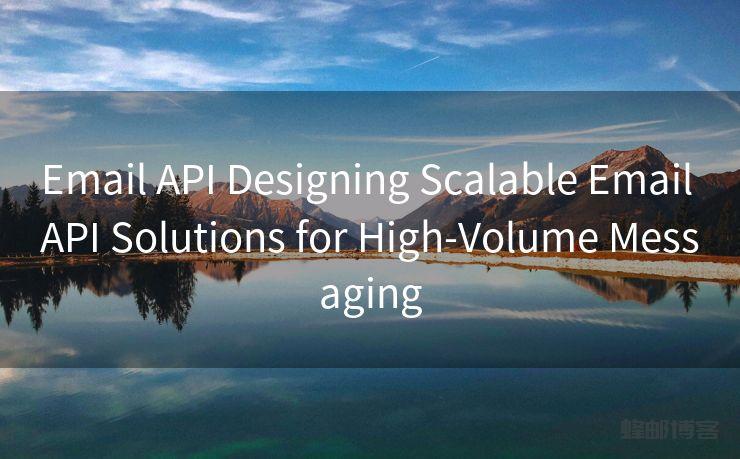Email API Designing Scalable Email API Solutions for High-Volume Messaging




Email API Designing Scalable Email API Solutions for High-Volume Messaging
Email API:Introduction
In today's digital age, email remains a crucial communication channel for businesses and individuals alike. Whether it's for marketing campaigns, transactional messages, or notifications, the demand for reliable and scalable email solutions has never been higher. High-volume messaging requires a robust infrastructure to ensure timely delivery, manage deliverability issues, and scale efficiently with growing demands. This article explores the key considerations and best practices for designing scalable email API solutions capable of handling high-volume messaging.
Email API:Understanding High-Volume Messaging
High-volume messaging refers to the sending of a large number of emails within a short period. Businesses may need to send millions of emails daily for various purposes, such as newsletters, promotional offers, order confirmations, and password resets. Managing such a high volume effectively requires addressing challenges related to deliverability, rate limiting, spam filters, and infrastructure scalability.
🔔🔔🔔
【AOTsend Email API】:AOTsend is a Managed Email Service for sending transactional emails. Support Email Types: reminders, authentication, confirmations, notifications, verification codes, invoices, password resets, account activations, billing statements, two-factor authentication (2FA), and one-time passwords (OTP) emails, etc. $0.28 per 1000 Emails. 99% Delivery, 98% Inbox Rate.
You might be interested in:
Why did we start the AOTsend project, Brand Story?
What is a Managed Email API, How it Works?
Best 25+ Email Marketing Platforms (Authority,Keywords&Traffic Comparison)
Best 24+ Email Marketing Service (Price, Pros&Cons Comparison)
Email APIs vs SMTP: How they Works, Any Difference?
Email API:Key Components of an Email API Solution
Email API:Email Sending Infrastructure
A robust email sending infrastructure is the backbone of any high-volume email solution. This includes servers, IP addresses, and domain configurations. Ensuring that you have a sufficient number of dedicated IP addresses can help distribute the sending load and manage reputation. Additionally, implementing a scalable server architecture, such as using cloud-based solutions like Amazon SES, SendGrid, or Mailgun, can dynamically adjust resources based on demand.
Email API:Deliverability Management
Deliverability is a critical aspect of email success. High-volume senders must constantly monitor and manage their sender reputation to avoid being blacklisted by ISPs. This involves maintaining proper email authentication standards, such as SPF, DKIM, and DMARC. Additionally, engagement metrics like open rates and click-through rates should be tracked to adjust sending strategies and improve overall deliverability.
Email API:Rate Limiting and Throttling
To prevent being flagged as spam, it is essential to implement rate limiting and throttling mechanisms. ISPs have thresholds for the number of emails they accept from a single sender within a specific timeframe. Exceeding these limits can result in delayed or blocked emails. Throttling helps manage the sending rate, ensuring compliance with ISP policies and improving email delivery success.
Email API:Designing for Scalability
Email API:Cloud-Based Solutions
Leveraging cloud-based email solutions can provide the scalability needed for high-volume messaging. Cloud providers offer elastic resources that can scale up or down based on demand, ensuring that email delivery is not compromised during peak periods. Services like Amazon SES, Microsoft Azure, and Google Cloud Platform provide reliable and scalable infrastructures that can handle high email volumes efficiently.
Email API:Load Balancing
Load balancing is another critical component in designing a scalable email API solution. It distributes the sending load across multiple servers or IP addresses, preventing any single point of failure and enhancing performance. Load balancers can dynamically adjust to traffic patterns, ensuring that the email sending infrastructure remains responsive and efficient.
Email API:Microservices Architecture
Adopting a microservices architecture can enhance the scalability and maintainability of your email API solution. By breaking down the email sending process into smaller, independent services, you can scale each component individually based on its specific needs. This modular approach allows for easier updates, maintenance, and scalability, ensuring that the system can handle high-volume messaging effectively.
Email API:Monitoring and Analytics
Email API:Real-Time Monitoring
Real-time monitoring is essential for maintaining the health and performance of your email sending infrastructure. Tools that provide insights into email delivery rates, bounce rates, and engagement metrics can help identify issues promptly. Monitoring tools can also alert you to potential problems, such as server downtime or IP blacklisting, allowing for immediate corrective actions.
Email API:Analytics and Reporting
Detailed analytics and reporting are crucial for understanding the effectiveness of your email campaigns. Analyzing data on open rates, click-through rates, and conversion rates can provide valuable insights into recipient behavior and campaign performance. These insights can inform future strategies, helping to optimize email content and sending practices for better results.
Email API:Security Considerations
Email API:Authentication and Encryption
Ensuring the security of your email communications is paramount. Implementing strong authentication mechanisms like SPF, DKIM, and DMARC helps verify the sender's identity and protect against phishing attacks. Additionally, encrypting email content, especially for transactional messages, ensures that sensitive information remains confidential and protected during transmission.

Email API:Compliance with Regulations
Compliance with email regulations, such as the CAN-SPAM Act, GDPR, and CASL, is essential for maintaining trust and avoiding legal repercussions. These regulations govern various aspects of email marketing, including consent, content, and opt-out mechanisms. Ensuring compliance helps build recipient trust and protects your organization from potential fines and penalties.
Email API:Conclusion
Designing a scalable email API solution for high-volume messaging requires a comprehensive approach that addresses infrastructure, deliverability, scalability, monitoring, and security. By leveraging cloud-based solutions, implementing rate limiting, and adopting a microservices architecture, businesses can build a robust email infrastructure capable of handling large volumes efficiently. Real-time monitoring, analytics, and compliance with regulations further enhance the effectiveness and reliability of email communications. As the demand for high-volume messaging continues to grow, investing in scalable email solutions will be crucial for businesses to maintain effective and reliable communication with their audiences.




Scan the QR code to access on your mobile device.
Copyright notice: This article is published by AotSend. Reproduction requires attribution.
Article Link:https://www.mailwot.com/p1.html



